
Garuda is a Hindu deity who is primarily depicted as the mount (vahana) of the Hindu god Vishnu. This divine creature is mentioned in the Hindu, Buddhist and Jain faiths. Garuda is also the half-brother of the Devas, Gandharvas, Daityas, Danavas, Nāgas, Vanara and Yakshas. He is the son of the sage Kashyapa and Vinata. He is the younger brother of Aruna, the charioteer of the Sun. Garuda is mentioned in several other texts such as the Puranas and the Vedas.

Prambanan is a 9th-century Hindu temple compound in the Special Region of Yogyakarta, in southern Java, Indonesia, dedicated to the Trimūrti, the expression of God as the Creator (Brahma), the Preserver (Vishnu) and the Destroyer (Shiva). The temple compound is located approximately 17 kilometres (11 mi) northeast of the city of Yogyakarta on the boundary between Central Java and Yogyakarta provinces.

In various Asian religious traditions, the Nagas are a divine, or semi-divine, race of half-human, half-serpent beings that reside in the netherworld (Patala), and can occasionally take human or part-human form, or are so depicted in art. A female naga is called a Nagi, or a Nagini. Their descendents are known as Nagavanshi and Nair. According to legend, they are the children of the sage Kashyapa and Kadru. Rituals devoted to these supernatural beings have been taking place throughout South Asia for at least 2,000 years. They are principally depicted in three forms: as entirely human with snakes on the heads and necks, as common serpents, or as half-human, half-snake beings in Hinduism, Buddhism, and Jainism.

Osian is an ancient town located in the Jodhpur District of Rajasthan state in western India. It is an oasis in the Thar Desert. The town is a panchayat village and the headquarters for Osian tehsil. It lies 69 km (43 mi) by road north of the district headquarters at Jodhpur, on a diversion off the main Jodhpur – Bikaner Highway. The under-construction Amritsar Jamnagar Expressway passes through this town.

Naga Panchami is a day of traditional worship of Nag or snakes observed by Hindus, Jains, and Buddhists throughout India, Nepal, and other countries where Hindu, Jain, and Buddhist adherents live. The worship is offered on the fifth day of bright half of lunar month of Shravana (July/August), according to the Hindu calendar. Some Indian states, such as Karnataka, Rajasthan and Gujarat, celebrate Naga Panchami on the dark half of the same month. As part of the festivities, a Naga or serpent deity made of silver, stone, wood, or a painting is given a reverential bath with milk and their blessings are sought for the welfare of the family. Live snakes, especially cobras, are also worshipped on this day, especially with offerings of milk and generally with the assistance of a snake charmer.

Wat Phra That Doi Suthep is a Theravada Buddhist temple (wat) in Chiang Mai Province, Thailand. The temple is often referred to as "Doi Suthep" although this is actually the name of the mountain where it is located. It is a sacred site to many Thai people. The temple is 15 kilometres (9.3 mi) from the city of Chiang Mai and situated at an elevation of 1,073 meters. From the temple, impressive views of downtown Chiang Mai can be seen.

Tenavaram temple is a historic Hindu temple complex situated in the port town Tenavaram, Tevanthurai, Matara) near Galle, Southern Province, Sri Lanka. Its primary deity was a Hindu god Tenavarai Nayanar (Upulvan) and at its zenith was one of the most celebrated Hindu temple complexes of the island, containing eight major kovil shrines to a thousand deity statues of stone and bronze and two major shrines to Vishnu and Shiva. Administration and maintenance was conducted by residing Hindu Tamil merchants during Tenavaram's time as a popular pilgrimage destination and famed emporium employing over five hundred devadasis.

The Sri Thendayuthapani Temple, better known as the Chettiars' Temple, is one of Singapore Hindu community's most important monuments. The temple was built by the Chettiars at Tank Road in 1859 and managed by the Chettiars' Temple Society. The temple was reconstructed in 1983 and renovated in 2022. The temple was gazetted as a National monument of Singapore on 20 October 2014.
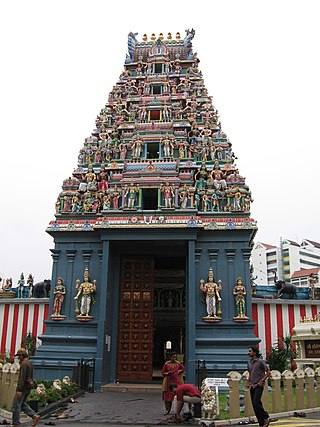
Sri Srinivasa Perumal Temple or Sri Perumal Temple is one of the oldest temples in Singapore. It is located in Little India within the planning area of Kallang along Serangoon Road, where its tall Gopuram (tower) shows the different incarnations of Lord Vishnu. This large complex, dedicated to Vishnu, dates from 1855, but the 20-metres-tall Gopuram was only built in 1966 at a cost of S$300,000. The temple's five-tier Gopuram was a donation from P. Govindasamy Pillai, one of the earliest Indian migrants to Singapore. In 1978, the temple was gazetted as a National monument of Singapore.

Nagaraja Temple is an early large temple found in the city of Nagercoil (Nagarkōyil) near the southern tip of Tamil Nadu, India. Its dating is uncertain but likely pre-12th-century. The main sanctum is dedicated to the Nagaraja – the king of serpents. Padmanabham (1985), Heritage Of The Tamils Temple Arts, Editors: SV Subramanian and G Rajendran, International Institute of Tamil Studies, Since the 17th-century, new Hindu shrines have been added to the temple complex attracting devotees of Krishna (Vishnu), as well as Shaiva and Shakti Hindus. The original iconography of the Tirthankaras and Padmavati Devi have and continue to remain a part of the sacred pantheon close to the temple's main sanctum.

The Tripurantaka Temple was built around c. 1070 CE by the Western Chalukyas. This temple, which is in a dilapidated state, is in the historically important town of Balligavi, modern Shivamogga district, Karnataka state, India. The exterior walls of the temple have erotic sculptures on friezes. These depictions are considered rare in Chalukyan art. Being miniature in size, these are visible only upon close examination. During medieval times, Balligavi was a seat of learning to multiple religious faiths and was home to many monuments and structures built by the Chalukyas. More than 80 medieval inscriptions have been discovered in Balligavi and belong to the Shaiva, Vaishnava, Jain and Buddhist faiths. These inscriptions describe, among other things, the building of temples.

Sambisari is a 9th-century Hindu temple located at Sambisari hamlet, Purwomartani, Kalasan, Sleman Regency, Special Region of Yogyakarta, Indonesia. The temple was buried about five metres underground. Parts of the original temple have been excavated. The temple is located about 8 kilometres (5.0 mi) east of Yogyakarta near Adisucipto International Airport.
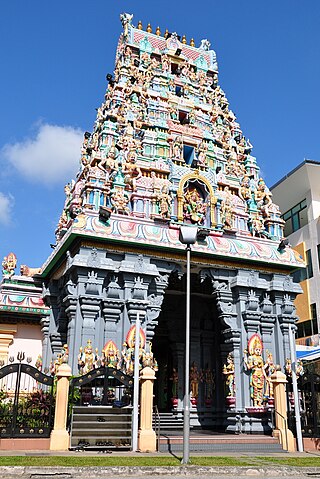
Sri Ruthra Kaliamman Temple is a temple for the goddess Kali who is the presiding deity, along Depot Road, in Bukit Merah, Singapore. The other deities of the temple include Sri Vinayagar, Sri Subramaniar, Sri Muneeswaran, Navagrahas, Sri Kaleeswarar, Sri Mangalambigai, Sri Dhakshinamoorthy, Sri Sandigeswarar and Sri Nandeeswarar.

Sri Sivan Temple is a Hindu temple in Singapore for the god Shiva. The temple was originally located in Potong Pasir from where it was moved three more times before finally coming to the present location, adjacent to Foo Hai Ch'an Buddhist Monastery, in front of Paya Lebar MRT station exit C at Geylang East Avenue 2.
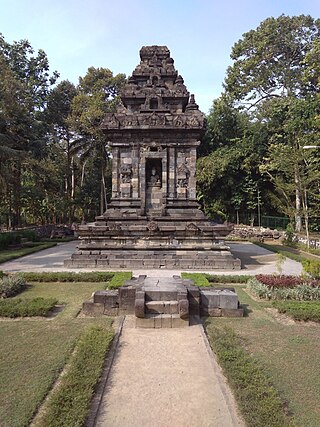
Merak temple, or locally known as Candi Merak, is a 10th-century Javanese Shivaist Hindu temple complex located in Karangnongko village, in Klaten Regency, northwest from Klaten town, Central Java, on southeastern slopes of Mount Merapi. The temple complex consisted of a main building and three perwara (ancillary) temples, dating from the 9th or 10th century, from the Mataram Kingdom.
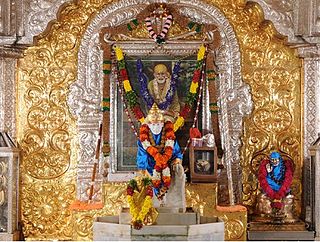
Sri Naga Sai Mandir is a Hindu temple dedicated to the Indian Spiritual Master Shirdi Sai Baba in Coimbatore in the Indian state of Tamil Nadu.
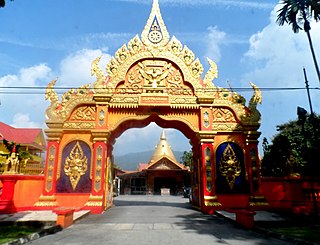
Wat Buppharam, also known as the Buppharam Buddhist Temple, is a Theravada Buddhist temple within George Town in the Malaysian state of Penang. Situated at Jalan Perak, the temple is the home to a renowned statue of Buddha, the "Lifting Buddha". It becomes a focal point for the annual Songkran, Loy Krathong and Vesak Day festivities within the city, as well as the Jathukarm-Ramathep-Ganesha blessing ceremonies.
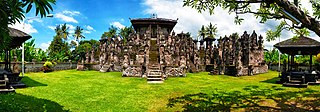
Pura Beji Sangsit is a Balinese temple or pura located in Sangsit, Buleleng, on the island of Bali, Indonesia. The village of Sangsit is located around 8 kilometres (5.0 mi) east of Singaraja. Pura Beji is dedicated to the rice goddess Dewi Sri, and is revered especially by the farmers around the area. Pura Beji is an example of a stereotypical northern Balinese architecture with its relatively heavier decorations than it is southern Balinese counterpart, and its typical foliage-like carvings.
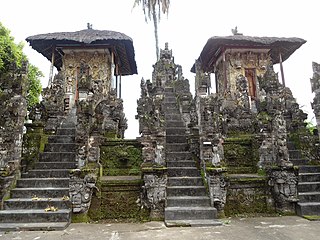
Pura Dalem Segara Madhu also known as Pura Dalem Jagaraga is a northern Balinese Hindu temple or pura located in the village of Jagaraga, Buleleng in northern Bali. It is about 11 km east of Singaraja. The village of Jagaraga is known historically as the place where the Dutch colonial government witnesses puputan or Balinese mass-suicide following their military attack on the kingdom of Bali in 1849. Pura Dalem Segara Madhu is known for its intensive wall decoration typical of northern Balinese architecture and for its unique western-influenced relief e.g. motifs of early 20th-century airplanes and automobiles.




















